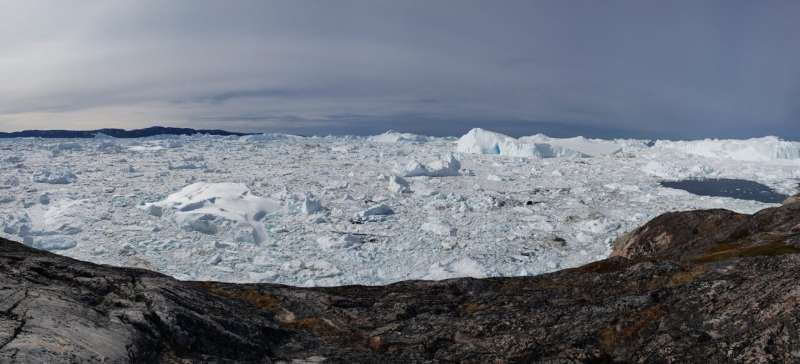This article has been reviewed according to Science X's editorial process and policies. Editors have highlighted the following attributes while ensuring the content's credibility:
fact-checked
peer-reviewed publication
trusted source
proofread
Warming has more impact than cooling on Greenland's 'firn,' physics-based model reveals

Scientists have known from ice core research that it's easier to melt an ice sheet than to freeze it up again. Now, they know at least part of the reason why, and it has to do with ice's "sponginess," according to a new study published July 24 in The Cryosphere.
The study uses a physics-based numerical model to assess the impacts of warming and cooling on firn, the porous layer between snow and glacial ice, over the entire Greenland Ice Sheet. Megan Thompson-Munson, a CIRES and ATOC Ph.D. student, led the study alongside her advisors: CIRES Fellow Jen Kay and INSTAAR Fellow Brad Markle.
"The amount of change that occurs within the firn layer due to warming and cooling is not equal in magnitude," Megan Thompson-Munson said. "If we look at thousands or millions of years, we see asymmetric ice sheet behavior overall: Ice sheets can melt away quickly, but take a long time to grow. This firn asymmetry we identify is a small piece of that puzzle."
Firn covers about 90% of the Greenland Ice Sheet, located at higher elevations where, along with snow, it covers hundreds of meters of ice and acts as a buffer against sea level rise—making it integral to preserving Arctic glaciers in a warming climate. Firn is porous and spongy, which allows water to pass through on its way to the solid ice layer below, where it can refreeze, adding to the existing ice sheet instead of flowing to the ocean.
In this study, researchers found warming temperatures are rapidly changing how efficiently firn can store meltwater, and cooling temperatures may not help the firn fully recover as much as scientists might have hoped.
"The warming depletes what we call the 'firn air content' or the 'sponginess," Thompson-Munson said. "So you lose more of the sponginess due to warming than can be regained due to cooling. And it's important because this porous firn can buffer the ice sheet's sea level rise contribution."
To understand how firn responds to both warming and cooling temperatures, the team used a physics-based computer model called SNOWPACK, and honed in on one variable: temperature. The study is the first of its kind in two ways. First, researchers looked at the impacts of both warming and cooling temperatures on Greenland firn. Second, the scope of the research covered the entire ice sheet, while previous studies focused on smaller geographical areas.
"The Greenland ice sheet loses mass faster under warming than it gains mass under cooling," said Kay. "The key advance of this study is that Greenland's firn contributes to this greater warming-than-cooling asymmetric response."
Thompson-Munson said the study brings up an important question regarding geoengineering and the ability to reverse our Earth's warming. Any geoengineering concepts designed to decrease temperatures in the Arctic might not preserve ice and snow as efficiently as imagined; the degree of cooling will have to exceed the degree of warming to help firn and glaciers return to normal.
"To get back to initial conditions, we'd have to cool a lot more or start changing other variables as well," Thompson-Munson said. "It's hard to reverse what we've already done."
More information: Megan Thompson-Munson et al, Greenland's firn responds more to warming than to cooling, The Cryosphere (2024). DOI: 10.5194/tc-18-3333-2024
Journal information: The Cryosphere
Provided by University of Colorado at Boulder



















